You Are Here: Home » Choosing Table Tennis Equipment » Types of undercarriages for Table Tennis Tables
Choosing Table Tennis Tables
Top tips to help you choose your best table tennis table.
Part four - what type of undercarriage do you need?
By Martin Hughes
Owner and Editor
Part One | Part Two | Part Three | Part Four | Part Five | Part Six

In this six-part series looking at how to choose a table tennis table that'll be exactly right for YOU, we've already covered parts one, two and three.
In part one we looked at the size dimensions of a table tennis table, how much room you need to play and how your table will be used, and in part two we looked at whether an indoor or outdoor table would be more suitable for your needs.
In part three we then looked at the different types of indoor tables which are available in order to determine which type of table will be best for YOU.
Want to buy a table? See my recommendations here.
Well, let's now take a look at a very important criteria that you need to consider before you buy a table tennis table - the undercarriage.
TABLE TENNIS EXPERT
REVEALS HIS SECRETS
Click Here For Details

Click here for a large selection of
table tennis equipment at Megaspin *

Click here for a large selection of
table tennis equipment at Bribar *
^ Top of page ^
So, you've decided that you need a regular, full-sized table, but...
What type of undercarriage is best?
Whether you're buying an indoor or outdoor table, one of the most important items to check before buying it is - what type of undercarriage does it have?
There are many different variations available, so you'll need to be clear about how your table will be used so that you can choose the right one for you.
TABLE TENNIS EXPERT
REVEALS HIS SECRETS
Click Here For Details

Click here for a large selection of
table tennis equipment at Megaspin *

Click here for a large selection of
table tennis equipment at Bribar *
1. Rollaway / Wheelaway
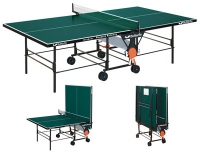
Some tables are known as "rollaway" or "wheelaway" because they have the undercarriage, wheels and table all integrated into one neat unit.
They do take up more storage space than other tables and can be up to 6 feet (1.83m) high when closed. This extra height can cause problems if you need to negotiate steps or transport them between venues.
However, if you store them close to where they'll be used, and they're on the same level, they can often be erected and dismantled by just one person, whereas most tables require at least two people.
There are several different variations of "rollaway" design and some can be used "half-open" to give a "playback" facility - so you can practice without an opponent by hitting the ball against the upturned half of the table!
^ Top of page ^
2. Separate halves
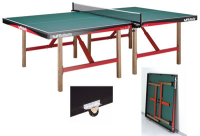
Other tables are in two separate halves.
The legs are attached to the underside of the table top and the wheels are incorporated into the centre edge of the table.
These types of table are easier to store and take up less space than a rollaway, but you'll need at least two people to erect and dismantle them.
These tables can have their undercarriage made of metal or wood. Personally, I prefer table tennis tables with wooden legs because I think they provide a much better foundation and better playing characteristics.
^ Top of page ^
3. Are there any players who are wheelchair users?
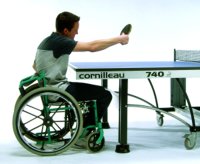
If your table will be used by any table tennis players who use a wheelchair, then the position of the table legs is very important.
Some tables have the legs positioned very close to the end of the table, whilst others are set back towards the middle of the table.
A wheelchair user will need the table legs and undercarriage set back at least 40cm (16 inches) from the end where he'll be playing.
The International Table Tennis Federation recommends that manufacturers add the letter W and "for wheelchair play" either on the frame or on the undercarriage - so look out for that if you need one of these tables.
^ Top of page ^
4. Innovative designs
If your table will be used in high profile events, you may want to consider something more eye-catching!
A recent innovation has seen table tennis manufacturers produce undercarriages which are made especially for televised tournaments.
These have revolutionary undercarriage designs or use covers to hide the legs.
Some are available to buy, but some designs are only made for specific tournaments.
However, at the end of a tournament the tables are often sold off, so you may be able to buy one from the tournament organiser.
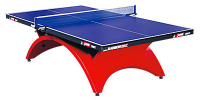
My favourite example of a new undercarriage design is this Double Happiness (DHS) Rainbow table...

but there are other examples - like this andro table...

... and this Donic table...
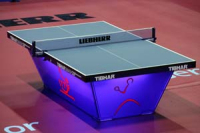
... and this Tibhar table with the table legs covered up ...
So, when you've decided what type of table tennis table undercarriage is best for you, you'll need to look at one more vital component...
The table top surface - and we'll take a look at that in part five...
Part One | Part Two | Part Three | Part Four | Part Five | Part Six
^ Top of page ^
Click here for a large selection of
table tennis equipment at Megaspin *

Click here for a large selection of
table tennis equipment at Bribar *
^ Top of page ^
Click here for a large selection of
table tennis equipment at Megaspin *

Click here for a large selection of
table tennis equipment at Bribar *
^ Top of page ^
